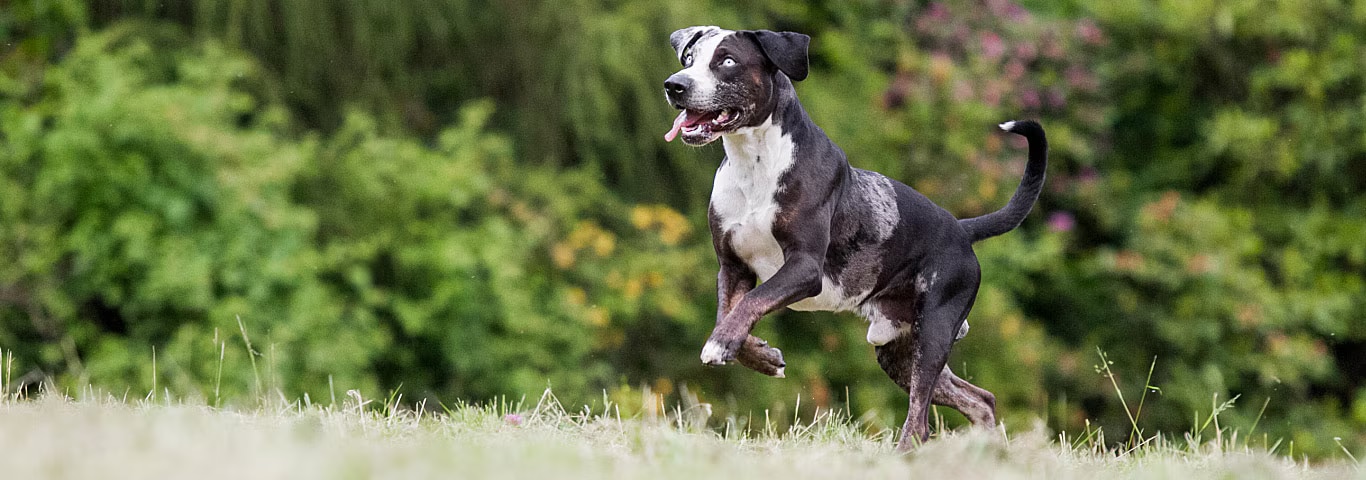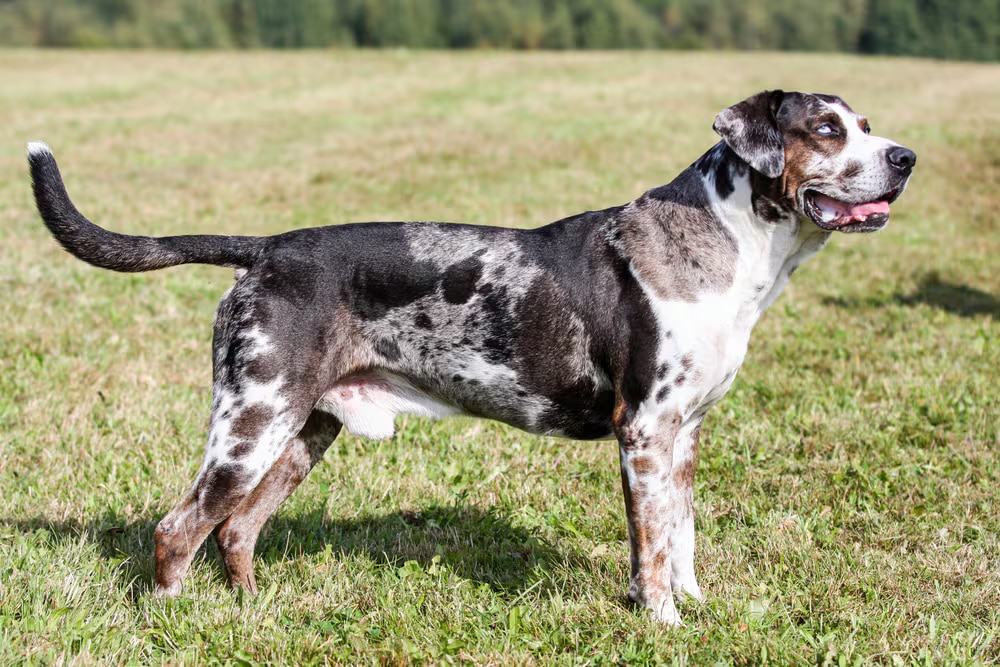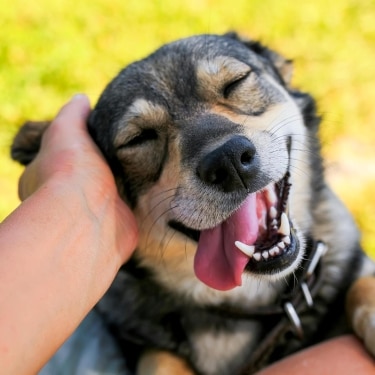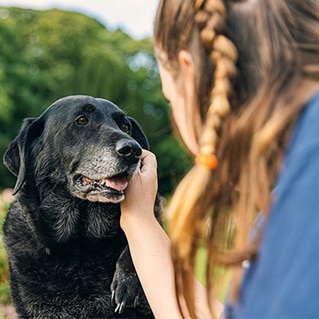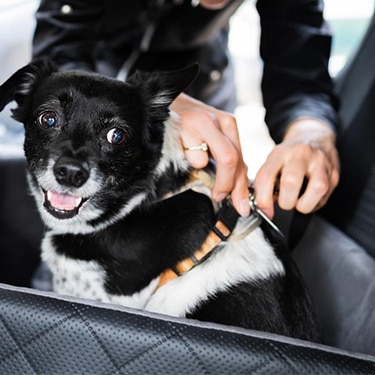The Catahoula dog's eyes are just as striking. Although some have brown eyes, it's more common to see "glass" eyes that are a very pale blue, almost white in appearance. Blue, green and amber are also common, and it's not unusual for this breed to have different colored eyes. Often, two colors exist in the same eye, as either a "cracked" appearance, in which the eye is split into two different colors, or as a spotted appearance.
This is a medium-large breed, ranging from 50 to 95 pounds (ca. 43 kg) and reaching up to 24 inches (0.61 m) at the withers. Though their bodies are muscular, they're streamlined and agile rather than stocky. The head has a broad skull with defined cheekbones and a long snout housing a mouth with a normal bite. The uncropped ears are set level with or slightly below the top of the head and hang in angular folds next to the cheeks. The long, tapered tail is often carried high and should be left undocked.
The Catahoula Leopard Dog temperament is intense, serious and focused when working out in the field, and protective, playful and affectionate at home with their family. If properly socialized from puppyhood, Catahoulas aren't aggressive toward people, but they do tend to be wary and aloof around strangers.
While they can be taught to get along with other dogs of the opposite sex, they may become aggressive with dogs of the same sex. Their intense prey drive also makes them unsafe around cats and other small pets, cautions The Spruce Pets. Their tendency to bark at strangers, combined with their strong protective instincts, make them excellent watchdogs.
Catahoulas get along well with older children who are able to treat them with gentleness and respect, especially if raised with them from the time they're puppies. But they should be closely supervised around small children and infants. This breed is best suited for families with older children or teens who can participate in training and take a firm but gentle hand. It's important for all members of the family to deal fairly with these dogs, who won't hesitate to defend themselves if they perceive they're being mistreated, says Dogtime.
Catahoula Leopard Dogs feel most at home on a farm or ranch with livestock to herd and plenty of space to run and play. Barring that, they need a home with a large, fenced-in yard, and they need to be provided with an outlet for their herding and tracking instincts. This breed excels in hunting and tracking sports, as well as in agility and obedience training.
Your Catahoula will need at least an hour of physical exercise a day. They make a great companion for an active pet parent who enjoys running, hiking or long walks. But because of their aggression toward other dogs and their tendency to chase small animals, they may not be the best candidates for dog parks, and they should never be allowed off leash. In addition to physical exercise, Catahoulas need mental stimulation through sports, interactive games or training activities. Without it, they'll become bored, which could lead to destructive behavior.
Despite their love for the outdoors, this isn't a breed who can be left outside. Catahoulas hate to be left alone for long; they need to spend plenty of quality time with their human pack. Crate training from an early age, combined with treat-dispensing puzzle toys to keep them occupied, can help keep them calm and contained when it's necessary to leave them alone for a few hours.
Catahoulas are highly intelligent and fairly easy to train. They do possess an independent streak that can make them stubborn at times, so it's important to be firm and patient as well as fair and gentle. Clear expectations and consistency will go a long way toward earning your Catahoula's respect and obedience. Overall, these pups are eager to please and tend to be motivated by praise.
This is a hardy breed that generally has very few health problems. Like many large breeds, they're predisposed toward hip dysplasia, but this should be screened out by reputable breeders. If you purchase a Catahoula puppy from a breeder, ask to see health clearances for both parents, which should include a hip screening from the Orthopedic Foundation for Animals.
Deafness may also be a concern with this breed, a condition that's genetically linked to the gene for merle coloration. While you can test their hearing prior to bringing your Catahoula home, keep in mind that while deafness will require some minor accommodations, dogs with hearing loss can be just as happy and productive as hearing dogs.
The Catahoula dog's fur ranges from smooth to coarse and does a good job of repelling dirt on its own. Light shedding year-round can be easily managed with weekly brushing, and you'll only need to bathe your Catahoula when they become muddy or stinky. Trim the nails whenever you hear them tapping against the floor. Ears should be inspected and cleaned with an ear solution once a week to prevent infection or wax buildup that can contribute to hearing loss. Ideally, teeth should be brushed daily, or two to three times a week at a minimum. Annual dental checkups and cleanings by a veterinarian will also be necessary to prevent gum and dental diseases.
The Catahoula's history can be traced back to the 1500s. Spanish explorers in Florida and along the Gulf Coast began breeding the European mastiffs, bloodhounds and greyhounds they'd brought with them to a wolf-like dog that had been domesticated by the local Choctaws and other indigenous tribes. The Native Americans called these new mixes "wolf dogs." Centuries later, when the French settled around Catahoula lake in Northern Louisiana, they bred these cross-bred "wolf dogs" with their own hounds. This breed became the modern Catahoula Leopard Dog, which was named Louisiana's official state dog in 1979.
While both the settlers and indigenous people alike appreciated this new breed's usefulness in tracking and hunting deer, bobcats and feral hogs, it was their talent for hemming in and rounding up wild hogs and stray cattle that cemented their reputation as a working breed. Unlike other herding breeds, Catahoulas developed a unique style of creating a "canine fence" around the livestock that allows the human handler to direct the herd. When it comes to breeding, it's their instinct, more than appearance or temperament, that makes a Catahoula.
Both the Louisiana Catahoula Cur Association and the National Association of Louisiana Catahoulas were formed in the late 1970s to track and register this breed and govern the breed standard. England's United Kennel Club was the first national dog club to recognize this breed in 1996, classifying it as a herding breed. Currently, the American Kennel Club (AKC) doesn't officially recognize this breed, although it has been entered as a rare breed in AKC's Foundation Stock Service.
Adopt a pet. Change a life.
Are you prepared to adopt a pet? Use these tools to make sure you are ready for the commitment.
Adopt a pet. Change a life.
Are you prepared to adopt a pet? Use these tools to make sure you are ready for the commitment.












